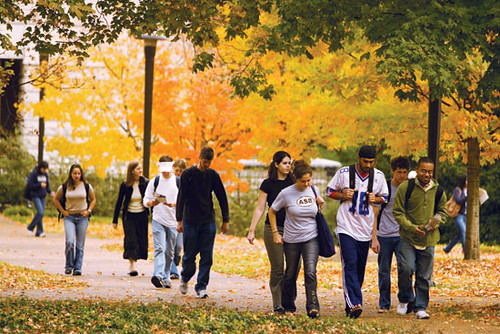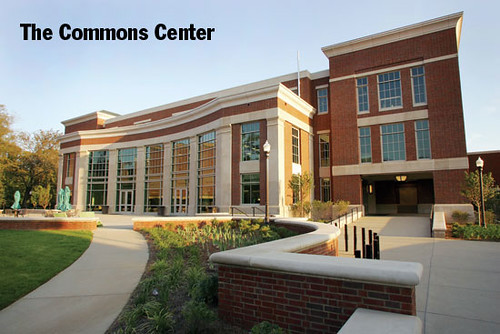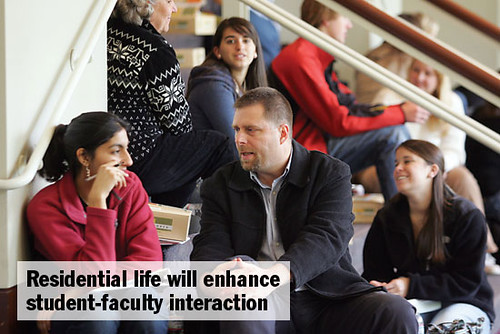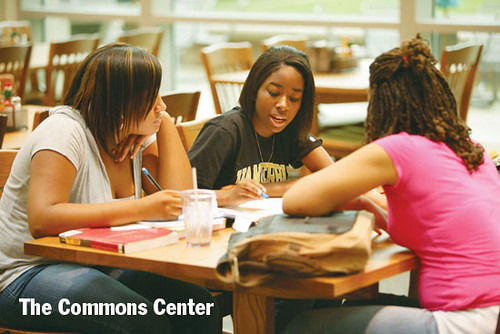
From the moment they step onto campus next August, the 1,550 students in the Class of 2012 will be pioneers in one of the most comprehensive changes in Vanderbilt history. Each incoming student will live in one of 10 residential “houses” led by a faculty head who lives with students and residential life staff. Collectively known as The Commons, this residential community is the first step in Vanderbilt’s College Halls program.
The Commons promises significant new forms of faculty involvement and student learning for undergraduates. Students in each house will dine together, socialize together, and call upon faculty mentors for a range of needs, academic and otherwise. Each house will create its own identity, plan its own activities, and manage its own programming budget.
“As a colleague of mine says, we’re aboutto open Pandora’s box,” says Associate Professor of History Frank Wcislo, Vanderbilt’s first dean of The Commons and a passionate advocate for the program. “But in this instance, the box is filled only with good.”
After nearly a decade of planning, Vanderbilt is investing $150 million in the first phase of College Halls. Much more than bricks and mortar, these projects mark Vanderbilt’s leadership in an educational movement that in recent years has been taking root at leading universities not only in the United States–such as at Princeton, MIT and Northwestern–but around the world.
While The Commons focuses on first-year students, the university’s current plan aims eventually to build a series of College Halls for all interested upperclassmen. Early planning for the next two such College Halls, each of which would house about 300 sophomores, juniors and seniors together with resident faculty and graduate students, is already under way.
The residential college movement is “a real generational transformation, and there are at least two motivations behind it,” notes Robert J. O’Hara, an evolutionary biologist who is one of the world’s leading advocates of the residential college movement. “One is a rejection of the mid-20th century’s obsession with bureaucratic centralization, an outlook that treated education almost like an industrial process. Another is a desire to repair the damage done by the self-centeredness of the 1960s. Residential colleges are being established at universities in the United States, Canada, Mexico, Germany and China, and they are joining established systems in Britain, Australia, New Zealand and elsewhere.”
This model that is gaining new advocates in the 21st century is patterned after the 700-year-old residential college systems of Oxford and Cambridge universities. Whether referred to as residential colleges, a house system or college halls, the intent is the same at such places as Harvard, Yale, the University of Pennsylvania and Rice: intimate residential-based communities of faculty and underclassmen living together and engaging in social and educational programming. Hogwarts, the school of magic attended by Harry Potter, provides a literary example of College Halls, minus the moving staircases and talking portraits.
“A residential college experience is absolutely at the heart of what Vanderbilt has always been about,” says Susan Aston Barge, BA’81, associate provost for College Halls. “Even though Vanderbilt’s growth in recent years has meant more students living off campus, it was never in keeping with our mission.”
Where Everybody Knows Your Name
With the building of The Commons, notes Dean of Students Mark Bandas, Vanderbilt is finally achieving a long-stated goal that all students, with few exceptions, live on campus.
“Vanderbilt has never had enough housing available, so our insufficient space issues have allowed some students to live off campus,” says Bandas. “Especially as enrollment grew, housing couldn’t keep up with demand.”
That’s about to change. Beginning next fall nearly 100 percent of undergraduates will live on campus. Only students requesting to live with an immediate family member whose primary residence is in Davidson County may live off campus. That is a fairly substantial change from recent years, when as much as 15 percent of the undergraduate population lived elsewhere.
The move back toward a residential emphasis began nearly a decade ago when, at the request of College of Arts and Science faculty members, former Provost Thomas Burrish charged a committee of faculty, students and administrators with exploring the possibility of a residential college system at Vanderbilt. Chaired by then-Associate Provost Nicholas Zeppos (now interim chancellor, provost, and vice chancellor for academic affairs), the committee examined the educational outcomes of learning communities, met with representatives from institutions with residential colleges, and conducted internal research on the thoughts and needs of Vanderbilt students.
One troubling finding of their research at the time was data showing that during the previous five years, approximately 8 percent of Vanderbilt first-year students did not return for their sophomore year–a poor retention rate compared to other top universities. It is during the transitional year from high school to college that students face the greatest risk of isolation and benefit most from increased interaction and faculty mentoring.
“Students who are able to find their ‘niche’ at Vanderbilt tend to remain and graduate,” the committee reported. “Conversely, students who do not socially integrate and develop no strong ties to a community, student organization or academic program have a significantly lower rate of retention.”
Soon after the committee released its report, the residential college idea gained momentum from the convergence of three personalities at Vanderbilt: Gordon Gee was installed as the university’s seventh chancellor, Nicholas Zeppos became provost and vice chancellor for academic affairs, and the Board of Trust was chaired by tireless student advocate Martha Ingram.
Zeppos explains how that which is special about Vanderbilt has continuously served as the project’s Polaris. “We asked what Vanderbilt is about,” says Zeppos, “and the answer always was the unique connection between faculty and students and the transformation young people go through in their college years. Vanderbilt stands for collegiality, vitality, balance and community, respect and caring, and College Halls builds upon all of that.”
Ingram’s own residential college experience during her days as a Vassar student helped her envision such a model at Vanderbilt. “It concerned me that we had students who were bright enough to get into Vanderbilt, who had all the credentials, but who weren’t staying here because they didn’t know how to fit in,” she says. “Helping every student maximize his or her potential is what Vanderbilt is all about, and that means making the experience welcoming and challenging intellectually for everyone who comes here.”
The immediate price the university pays when a student fails to become engaged is loss of that student to another institution. But there are also ramifications if the student stays. Disengaged students make less of an academic contribution to Vanderbilt and become unenthusiastic, disconnected alumni.
“The solution is to make complex institutions into smaller units where students don’t get lost in the shuffle,” says Lucius Outlaw Jr., associate provost of academic affairs and professor of philosophy.
At present, Vanderbilt students have three very different versions of a first year at Vanderbilt depending on which of the three freshman areas of campus they live in–Kissam Quadrangle, Branscomb Quadrangle or Vanderbilt/Barnard Halls. Having all first-year students together will help standardize the freshman experience.
By building The Commons, says Outlaw, “we are creating small residential institutions within the institution that decrease our scale and increase our intimacy with students at this critical time in their lives.”
Vanderbilt already has a model of sorts in its existing Living and Learning Centers–Mayfield, McGill and McTyeire. The committee headed by Zeppos found in 1999 that students of these residences had, on average, SAT scores 30 points higher than other entering Vanderbilt students; had high school GPAs higher than other entering Vanderbilt students; and were more likely to receive an honors scholarship.
The 10 houses of The Commons are all located on Vanderbilt’s east side, adjacent to and architecturally harmonious with the historic Peabody College buildings, but within a short walk of the center of campus thanks to two bridges over 21st Avenue. They include meeting spaces for students, seminar rooms, laundry facilities, wireless Internet services, and specially designed apartments for faculty heads of house. Five of the houses were built from the ground up, and five were transformed from residence halls built at Peabody College, most in the 1920s. Also new is The Commons Center, a multipurpose recreational, educational, dining and community center. That section of campus provided the perfect location for such an enterprise, notes Judson Newbern, associate vice chancellor for campus planning and construction, because it was “a contiguous area that had been under-realized and underinvested in over the years.” The Commons continues the feeling of the original surrounding Peabody structures by using similar architecture. It features four quadrangles and takes advantage of the popular green spaces of Magnolia Lawn and the Peabody Esplanade. Every space was designed with accidental interaction as a goal. Planners found that students don’t like congregating in huge lobbies–but one place where they do hang out is the laundry room. So laundry rooms were placed right off the house lobbies. Small coffeehouse-type spaces also encourage social exchanges.
Certain amenities were omitted in order to foster integration of first-year students into campus life among upperclassmen. Student mailboxes continue to be located in the Station B Post Office, and the Student Recreational Center is still the best place on campus for a good workout and for intramural sports. A five-minute walk gets one to Library Lawn and the Stevenson Center, and in approximately five minutes more, one arrives at the Rec Center, Sarratt Student Center or Greek Row.
“It’s creating a whole new front door to Vanderbilt,” says Wcislo.
The Professor Next Door
The 10 senior faculty who will serve as heads of house are a diverse mix of empty-nesters and young professors. Faculty heads will interact with students through such formal means as sponsoring lectures and conversations with visiting faculty, as well as informal means–hosting study breaks and afternoon teas and eating meals in the Commons Center dining hall.
Faculty will live with their families in a university-furnished apartment. These two- and three-bedroom residences each have a separate exterior entrance and interior space specifically for the purpose of entertaining other members of the house and of The Commons.
“I suspect that living and learning in The Commons will redefine life at Vanderbilt, and not only for its students,” says faculty head Greg Barz, associate professor of ethnomusicology. Barz, his wife, Mona, and their two children, ages 12 and 7, will move into North House next fall. “Faculty and staff will be significantly affected by our deep involvement in the everyday lives of our students.”
Mona Barz, a pastoral counselor, adds, “While we expect we may feel a certain loss of privacy, we are looking forward to experiencing everyday life at Vanderbilt. Our children think it will be a lot of fun to eat in the dining center, use the green as their front yard, and get to know the students.”
What faculty will not be is some kind of über-RA. “I have no intention of patrolling the hallways,” says Wcislo. “I view this as an opportunity to do more of what I love best–teaching.”
Visions and Revisions
Underpinning the bricks and mortar of College Halls is Vanderbilt Visions, a first-year core program in which small groups of students, facilitated by a faculty member and a student VUceptor, come together outside the classroom in new ways. Groups will complete at least one community service project, get together for social outings, and discuss dozens of topics in the social and political realms as well as the values and expectations of the Vanderbilt community.
While first-year students won’t move into The Commons until fall 2008, Vanderbilt Visions began in fall 2006.
Stuart Hill, a senior in the Blair School of Music and president of VUcept, the student-led organization that administers the Vanderbilt Visions program, recalls his first year at Vanderbilt. “I knew my professors, and I was getting a great education,” he says. “But I wondered if my friends were more just company rather than the type of fulfilling friends I had envisioned spending time with at college. Becoming involved in summer academic orientation–a precursor to the Vanderbilt Visions program–helped me realize there were other people here and gave me a broader perspective.”
With The Commons and Vanderbilt Visions, that broader perspective could be possible for all students early on. “This isn’t just about making friends,” Hill continues. “Participants of Vanderbilt Visions are getting mentorship about how to become better learners, how to become more active participants in the Vanderbilt community.”
Not every student shared Hill’s enthusiasm for Vanderbilt Visions in its first year. An evaluation a few months into the program revealed that only a third of first-year students approved of it. Based on that early feedback from student focus groups, discussion topics have since been geared more specifically to the Vanderbilt experience. VUceptors have been given flexibility to think proactively about how their groups adapt the curriculum. And the size of each Vanderbilt Visions group was scaled down from 20 to 15.
“It is the development of relationships we’re really going after,” says Ann Neely, associate professor of the practice of education, who is participating in her second year with Vanderbilt Visions. “This is part of the purpose–to create opportunities for students and professors to have intellectual conversations outside the classroom.”
While some students have always managed to make connections with a particular faculty member–an adviser, the instructor of a favorite course, a lab director–many undergraduates find it intimidating to approach faculty beyond the confines of a classroom.
In addition to faculty heads of house, Vanderbilt Visions involves more than 100 faculty section leaders who meet weekly with small groups of first-year students. This program alone has greatly increased interaction between students and faculty.
“Students sit down with an engaged, involved upperclassman and a prominent faculty member for an hour a week for the entire year,” says Cara Bilotta, a senior in the College of Arts and Science and current president of Vanderbilt Student Government. “They can pick each other’s brains about Vanderbilt and about the world in a way that isn’t possible inside a classroom. This is where we start to blow apart the boundaries between students and faculty.”
Even with the fine tuning of Vanderbilt Visions, though, some students have yet to embrace the whole notion of their university’s becoming a residential community. “Basically, we are frustrated because we feel like students will suffer in [not having residence options for] price and quality now that the university will not have to be competitive when it comes to housing,” says Taylor Gould, a junior in the College of Arts and Science and co-founder of the Facebook group Students Against the College Halls Initiative. “Everyone is focused on College Halls, which is great, but this shouldn’t mean that no one focuses on current students.”
The rise of The Commons also has fueled rumors that the project will sound the death knell for the university’s Greek system.
“I think Greek life at Vanderbilt will continue to be a major part of the Vanderbilt community, no matter where the freshman class is housed,” counters Erik Johnson, a senior in the College of Arts and Science and president of the Interfraternity Council. “Any concerns the Greek community may have about The Commons or College Halls stem from fear of the unknown.”
As to charges that College Halls is Vanderbilt’s attempt to copy its Ivy League competitors, says Bilotta, “I think a lot of these concerns stem from a misunderstanding of what College Halls will be. They’ve been designed to adapt to student needs and student wants, and the planning process has involved students from the very beginning. We take a lot of pride in being a great university in the South, in our unique Vanderbilt-ness.”
“Some schools claim to have residential colleges and many have faculty who live on campus, but they have little interaction with students,” adds Susan Barge. “We are already unique among other top schools in our commitment to the undergraduate experience.”
So far the effort is bringing Vanderbilt positive press, including mention in a July 2007 New York Times profile of residential colleges and a U.S. News and World Report citation of Vanderbilt’s College Halls as a “Program to Look For.”
“Vanderbilt has definitely enjoyed increased exposure and interest in the university of late, which can be tied, in part, to The Commons,” says Doug Christiansen, associate provost for enrollment management. “Parents and prospective students really get it when we talk about The Commons as a community of belonging, steeped in academic as well as social traditions and an increased ability for students to explore.”
Christiansen points out that while much of the spotlight is on College Halls, Vanderbilt is being noticed for “its very public and very deliberate focus on the undergraduate experience.”
Ultimately, says Nicholas Zeppos, almost all concerns about The Commons stem from a reaction to change. By their very nature, institutions of higher education are constantly evolving.
“People don’t want things to change, but what they have and love is the product of change,” says Zeppos. “I’ve been at Vanderbilt for 20 years and am fiercely protective of this place, but I will also always ask what can make us better. College Halls and The Commons are another chance for us to take our unique values forward.”
As Wcislo explains what the university hopes to create with The Commons, he is adamant that the undertaking not be viewed as an attempt to fix something that is broken, but rather that it be seen as a tool that can be used to make that which is good about Vanderbilt even better. With first-year students more engaged with each other and with faculty, the expected byproduct is a general increase in the intellectual atmosphere on campus.
“I’ve worked with Vanderbilt students who made me marvel at their confidence, at their intention, and at the deliberateness with which they engaged me,” says Wcislo. “This type of encounter, though, happens far less frequently with freshmen and sophomores. Let’s increase the opportunities for learning in these first two years.”
Vanderbilt students, faculty and staff have already begun to make the space of The Commons their own. For the last two years, upperclassmen have been breaking in new houses and living in newly renovated halls. The Commons Center opened for business in August and has already hosted a number of campus events. It regularly draws a large lunchtime crowd and coffee lovers from across campus, as well as from businesses on nearby Music Row and Hillsboro Village.
In the more ethereal arena of campus culture, there is an attitude of great anticipation–tinged with a bit of trepidation. “We must have tolerance for ambiguity as this project evolves,” says Barge. “Our goal is to get all the building blocks in place and then step away.”
“What really matters is this complicated, nebulous thing called university culture,” says Lucius Outlaw. “It’s going to take a while to build a Commons culture, and it’s only one aspect of our university’s culture. Changing the housing experience of our undergraduates isn’t going to blow open the doors of intellectual life by itself. It remains to be seen what we can pull off and how many years it will take.”


